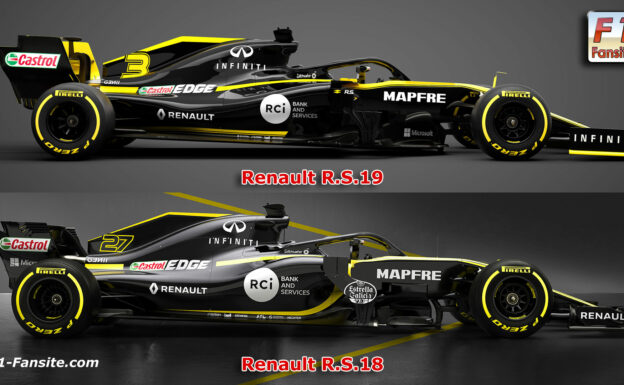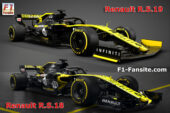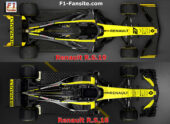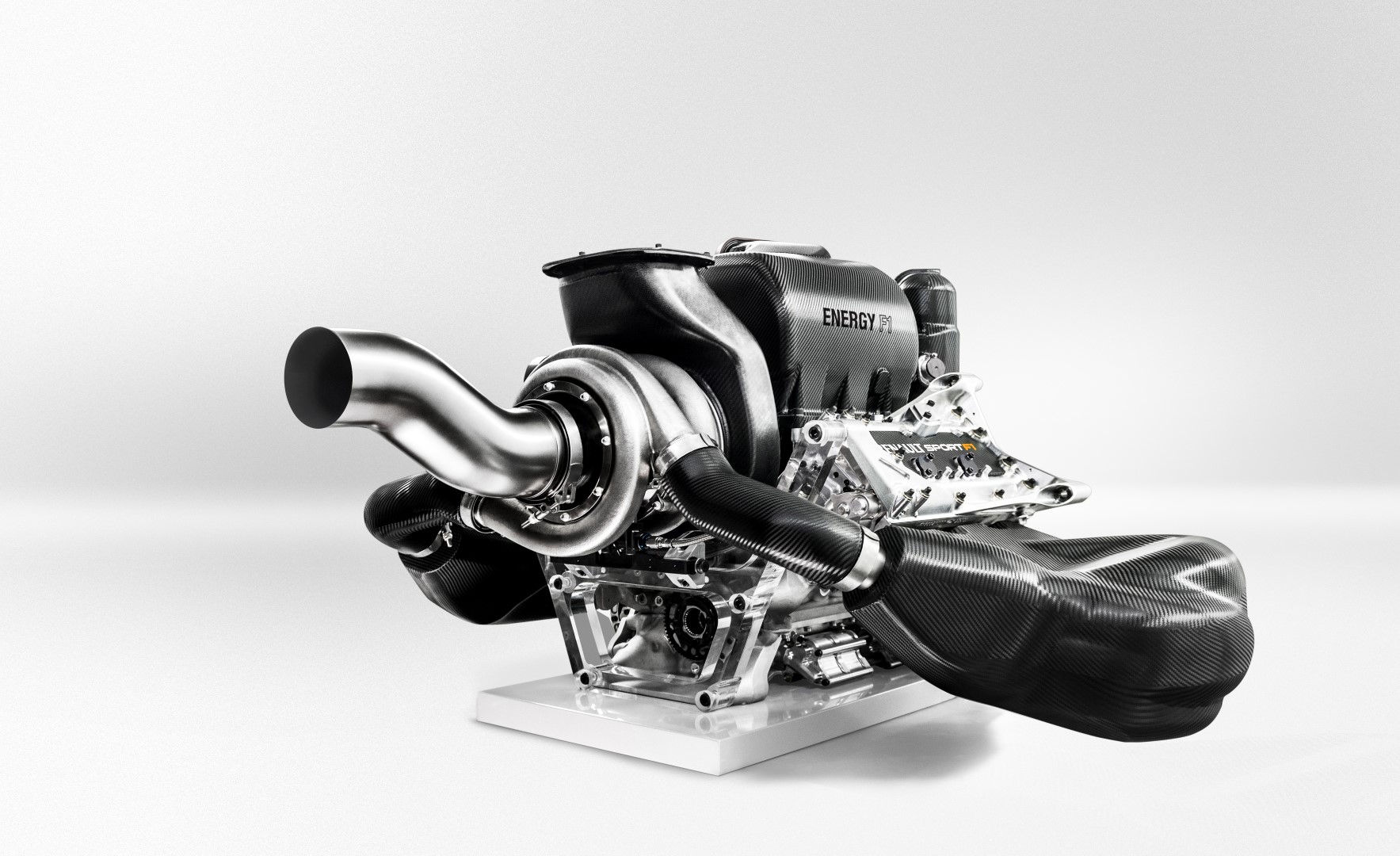Renault R.S.19 Launch F1 team interviews

At Renault, they are passionate about motorsport. Their history in F1 has continued unbroken for more than 40 years. Formula 1 is a show, a spectacle, pure entertainment, but it is also the highest level in motorsport.
A passion for Formula 1 is a metaphor for fighting spirit, determination, resilience but also progress thanks to the limitless innovation that inspires the sport.
This passion has to be tempered with a healthy dose of reality. A check to make sure the heart is matched by the head. And it still does. F1 makes sense for Renault; it is a laboratory for our future road going technology – as seen by the new engine designation – Renault E-Tech 19.
It also visits key markets on the global stage, such as China and Brazil, and continues to broaden its reach in emerging or consolidating markets such as the Middle East and Russia. Under the new owners, Liberty, F1 is more relevant too by attracting new fans that keep it young and fresh.
It is a very exciting time to be part of F1. Over the past three years they feel that they have proved themselves. Renault has contributed on-track with some great battles and strong performances. Off-track they have delivered innovative PR and marketing activities to help grow viewership and fan engagement.
2019 promises to be an interesting year on and off track. They can’t wait to get started.
Q&A WITH CYRIL ABITEBOUL
Renault Sport Racing Managing Director
Managing Director Cyril Abiteboul ensures all aspects of Renault Sport Racing are structured, resourced and working to their optimum to deliver on their performance potential. He also sets the commercial, marketing and communication targets to ensure Groupe Renault takes full advantage of its Formula 1 activities.
Cyril knows the Anglo-French team and Renault inside out. After graduating from the Institut National Polytechnique de Grenoble, he joined Renault in 2001 and worked in various positions at the company HQ in France and at the F1 team in Enstone. His commercial acumen saw him appointed Development Director of the Renault F1 Team in 2007, looking after commercial matters, partners and sponsor acquisition. He became Executive Director in 2010 before moving back to Viry in 2011 when Renault re-centred its F1 activities around engine supply. As Deputy Managing Director, Cyril oversaw all contractual relations, marketing and communications activities with partner teams and created a solid platform for Renault as it re-established itself in its new guise.
Cyril’s success in the role led to him being head-hunted by the Caterham F1 Team in 2012 to become team principal. He rejoined Renault in September 2014 to become Managing Director of Renault Sport F1 and successfully spear-headed the analysis of reacquiring and restarting a team for the Renault brand to continue its long F1 tradition in 2016.
Since then, Renault F1 Team has grown to be the most dynamic team on the F1 grid.
Q&A
2019 is the fourth season of Renault F1 Team. How much has the team progressed since returning to the sport in 2016?
I’m genuinely proud of the team in Enstone and Viry. Three years ago, we created Renault F1 Team with an ambitious programme, but with realistic hopes. We knew we needed to rebuild many elements of the company: facilities, workforce but also the confidence of the team. We introduced an extensive rebuilding programme in Enstone with new buildings and new production tools, including a wind tunnel upgrade, a new ultra-modern operations room, new chassis machine tools etc. A huge recruitment drive has also increased our workforce by fifty percent. Efforts have been made at Viry as well, with new investments in engine dynos and also in construction of a new building due for completion next year aimed to rehouse all engine assembly.
Launching all these projects while participating in the championship was an incredible challenge as was getting the major points finished. The final commissioning of the investments was a tremendous achievement and I’m impressed by how everyone has taken to the task. This shows in the momentum we have gathered: ninth in 2016 with eight points, sixth in 2017 with 57 points and fourth last year with 122 points.
We go into this season aiming to keep this strong and measured momentum. We do not target x or y position or a number of points: what I want to see is that the team continues its positive trajectory. The added momentum of the Daniel-Nico partnership brings confidence to the team this season.
How much are you looking forward to seeing our driver line-up behind the wheel of the R.S.19?
I can’t wait, and this feeling is shared by the entire team. I believe we have one of the strongest – if not the strongest – driver line-up on the grid. Daniel brings proven race winning experience and knowledge of a top team, while Nico is hungry. He’s hugely underrated – he’s quick, determined and a team motivator. Individually they are very strong and I feel the two will complement each other extremely perfectly.
Having two experienced and talented drivers is another motivating factor for the team. The energy they have brought to the team is very tangible and I hope we can give them a car to show their considerable talent.
MARCIN BUDKOWSKI
Renault F1 Team Executive Director
Marcin joined Renault F1 Team as Executive Director in April 2018 after roles at Prost GP, Ferrari, McLaren and the Féderation Internationale de l’Automobile (FIA).
He graduated from École Polytechnique, Paris, in 1999 and continued his studies between 1999 and 2001 at the Institut Supérieur de l'Aéronautique et de l'Espace (ISAE SUPAERO) and Imperial College London, specialising in Aeronautics and Aerodynamics.
Upon completion of his studies, Marcin began his career in Formula 1 in 2001 as an Aerodynamicist for Prost GP. Marcin then moved to Maranello, working for Ferrari between 2002 and 2007 in a period that saw the team winning multiple World Championships.
He then joined McLaren in 2007, working in a range of technical roles both at the factory and at the track, notably during the 2008 title winning year, before becoming Head of Aerodynamics in 2012.
His seven years at McLaren finished in 2014, moving to the FIA as Formula 1’s Technical and Sporting Coordinator, subsequently becoming Head of the Formula One Technical Department in 2017.
As Renault F1 Team’s Executive Director, Marcin is based at the team’s headquarters in Enstone, Oxfordshire. He oversees the day-to-day running and operation of the team, working closely with senior management and directors to ensure the team continues to meet its objectives.
Marcin is fluent in four languages: Polish, English, French and Italian.
Q&A
How much has Renault F1 Team changed in the past year?
The transformation at Enstone has been impressive and it matches our ambitions. We are putting the right tools in place for what we have set out to achieve. The change in infrastructure is visible with new buildings, older areas refurbished and new equipment commissioned. The design of the new offices and workshops has focused on every detail that can make a difference. Everything has been planned to ensure a smooth workflow. We have new flow measurement and analysis tools in the wind tunnel and a brand-new gearbox dyno that has recently been commissioned, improving our ability to develop the car. In modern Formula 1, all the small details add up, and that includes a better working environment for our staff that spend long hours at the factory.
What are the principal areas of improvement at Enstone?
We’ve had a massive growth – almost 100 new staff over the last year and 250 since 2016. The challenge is to integrate these new recruits in the team, but also to evolve our organisation and ways of working to make sure we extract the most performance and efficiency out of the increased headcount.
What does Renault F1 Team do well?
There’s a good core of people at Enstone who have been here for many years and created a good team spirit and work ethic; that’s a clear strength. The Enstone-Viry partnership is also very good having worked together for over 20 years. As a works team, having complete control over both chassis and engine is an advantage, and we are pushing this integration even further by making sure we approach a new car project as a whole with the two sides involved from the very early stages.
NICK CHESTER
Renault F1 Team Chassis Technical Director
Nick joined Enstone in 2000 and occupied various roles before becoming Chassis Technical Director in 2013.
Nick graduated from Cambridge in 1991 and joined Simtek Research in vehicle simulation. His first taste of Formula 1 came in 1994 with Simtek, before joining Arrows Grand Prix in 1995 for vehicle simulation and later suspension design. Nick was Performance Engineer for Damon Hill and Pedro Diniz in 1997 and then Race Engineer for Mika Salo and Pedro de la Rosa between 1998 and 1999.
Nick then moved to Benetton in 2000 as Test Engineer, working with Alexander Wurz, Giancarlo Fisichella and Mark Webber. Nick advanced to Performance Engineer for Fisichella in 2001 and Jarno Trulli in 2002-2004, contributing to the Italian’s sole Grand Prix win in Monaco in 2004.
2005 saw Nick step up to Head of Vehicle Performance Group (VPG), playing a part in Renault’s double championship wins of 2005 and 2006, including the development of the tuned mass damper system, which was a major innovation during that era.
Nick became Head of Performance Systems in 2010 and then Engineering Director in 2011, contributing to the development of the race winning E20 and E21. Nick then took the role as Technical Director responsible for the design and development of every Formula 1 car to come out of Enstone since 2013, including 2019’s R.S.19.
Q&A
Tell us about the 2019 Renault F1 Team car, the Renault R.S.19?
There has been significant evolution of the regulations, which were born from last season where cars couldn’t race closely together due to large downforce losses in aero wakes. The main changes for 2019, after discussions between the teams and the FIA over the course of last season, are a 200mm wider and simpler front wing, a change to the front drums, lower bargeboards and a bigger, wider and higher rear wing with increased DRS. It wasn’t a straightforward process in terms of interpreting the rules. We lost downforce in the early stages of the development. We’ve aimed to improve the overall packaging of the car, and notably to make the car lighter. We have a little more ballast to play with due to the minimum driver weight changing to 80kg.
What new resources has the team been able to harness for the creation of the R.S.19?
The whole capacity of the team has come up. The current infrastructure is top-level with better machining centres for chassis machining where we can work to tighter tolerances. We’ve made improvements to the wind tunnel, we have a paint shop on site, which means we can push things later and still have top quality finish. The new clean room is fantastic, it’s double in size from its predecessor, making composite lay-up more efficient and that’s helping us push to get the car ready. All over the factory there have been improvements and at the same time we’ve been building the engineering capabilities of the team. We’re still recruiting, enhancing our work processes and the organisation is strengthening all the time.
How much have the drivers influenced the development process of the car?
Nico is very good to work with because he’s clear with what he wants from the car. He knows the solutions we can give him that will make him go quicker. It’s very good talking to Daniel, he’s new to us and we’re new to him but he’s very open and his initial feedback is quite close to Nico’s. What we’re trying to put into the car should work for both of them. The closer they are with feedback, the easier it is to develop the car. It’s an incredibly strong line-up. They are both quick, they work hard and have great feedback.
REMI TAFFIN
Renault F1 Team Engine Technical Director
Rémi has been part of Renault’s Formula 1 involvement since 1999 and currently takes overall responsibility for the power unit developed at the Viry-Châtillon site. Rémi ensures the team of engineers produce an optimised unit that works in perfect harmony with the chassis.
After studying as a mechanical engineer at ESTACA, an engineering specialised school in Paris, Rémi’s first experience of motor-racing was in 1998 as a race engineer for Signature in Formula 3. In 1999, Rémi joined Renault working across the roll call of clients, including British American Racing as race engineer to Ricardo Zonta, Arrows as race engineer for Jos Verstappen, Benetton and Renault F1 Team.
He has worked directly with two World Champions, Jenson Button and Fernando Alonso, engineering the latter to victory in his two title-winning years. Rémi continued his race engineering role with Heikki Kovalainen in 2007 and Alonso again in 2008.
Rémi stepped up to manage Renault F1 track activities in 2009. Then with the creation of Renault Sport F1 in 2011, he took responsibility for the on-track engine performance of Renault Sport F1’s partners. Attending all races and tests throughout the season, Rémi oversaw customer support for the Renault-powered teams and was instrumental in the four world titles secured by Red Bull Racing in the V8 era.
In 2014 he became Director of Operations, managing the teams of engineers and technicians in the dynos and assembly department at Viry and ensuring a smooth transition to track by overseeing the engineers integrated to Renault’s partner teams. Since 2016, Rémi has managed Renault’s power unit development as Engine Technical Director.
Q&A
What has the team learnt from last year with its power unit development?
We confirmed last year that the direction we were developing the engine was the right method and that meant we could continue our efforts into 2019. Viry has been very busy over the winter and we have worked as late as possible to embed as much performance and reliability. We have now built the test engines and we are about to sign off race engines. We’re satisfied with what we’ve been able to produce. We’ve pushed on the pure performance element while also keeping a hand on reliability.
We’ve seen some major changes in Enstone this year, and Viry will undergo some major building work too. Can you explain?
We are constructing a new building for all our operational activities in order to improve the fluidity of our organisation. We will continue working on our test tools, ensuring we have the right and most up to date technology. We have a new dyno that will be commissioned shortly, which is multifunctional and can test the gearbox with the engine, the engine on its own, the ERS on its own and the engine with the rear end of the car. We have to keep the future in mind in anticipation of 2021 and looking after our preparation for that.
What’s the feeling within the team ahead of the season?
We are beginning to see the benefits between the collaboration of staff across both sites in Enstone and Viry. On the surface, we have seen new buildings and tools put in place, but we can’t forget the people at the heart of the project. There is a growing feeling that we can fight back at the top and staff are buying into that. There is no fear, we know we can do the job. We have people within the team who aren’t shy of the challenge to compete at the top. We know we have what it takes to deliver. Having two strong drivers in Nico and Daniel brings even more motivation and people within the team are convinced they can do a very good job. It delivers inspiration for staff to have an idea and subsequently develop that idea to the race car as quickly as possible.
- Renault RS19 VS Renault RS18 side view
- Renault RS19 VS Renault RS18 right-front view
- Renault RS19 VS Renault RS18 top view
| Chassis | Moulded carbon fibre and aluminium honeycomb composite monocoque, manufactured by Renault F1 Team and designed for maximum strength with minimum weight. Renault E-Tech 19 power unit installed as a fully-stressed member. |
| Front Suspension | Carbon fibre top and bottom wishbones operate an inboard rocker via a pushrod system. This is connected to torsion bar and damper units which are mounted inside the front of the monocoque. Aluminium uprights and OZ machined magnesium wheels. |
| Rear Suspension | Carbon fibre top and bottom wishbones with pull rod operated torsion bars and transverse-mounted damper units mounted inside the gearbox casing. Aluminium uprights and OZ machined magnesium wheels. |
| Transmission | Eight-speed semi-automatic carbon maincase gearbox with reverse gear. “Quickshift” system in operation to maximise speed of gearshifts. |
| Fuel System | Kevlar-reinforced rubber fuel cell by ATL. |
| Electrical | MES-Microsoft Standard Electronic Control Unit. |
| Braking System | Carbon discs and pads. Calipers by Brembo S.p.A. Master cylinders by AP Racing. |
| Cockpit | Removable driver’s seat made of anatomically formed carbon composite, with six-point harness seat belt. Steering wheel integrates gear change paddles, clutch paddles, and DRS. |
Dimensions and Weight
Front Track: 1600mm
Rear Track: 1550mm
Overall Length: 5480mm
Overall Height: 950mm
Overall Width: 2000mm
Overall Weight: 743kg, with driver, cameras and ballast
Renault E-TECH 19 technical specification
| Engine | |
| Displacement | 1.6L V6 |
| Number of cylinders | 6 |
| Rev limit | 15,000rpm |
| Pressure charging | Single turbocharger, unlimited boost pressure (typical 5 bar abs) |
| Fuel flow limit | 100kg/h |
| Permitted fuel quantity per race | 110kg |
| Configuration | 90° V6 |
| Bore | 80mm |
| Stroke | 53mm |
| Crank height | 90mm |
| Number of valves | 4 per cylinder, 24 |
| Fuel | Direct fuel injection |
| Energy Recovery Systems | |
| MGU-K rpm | Max 50,000rpm |
| MGU-K power | Max 120kW |
| Energy recovered by MGU-K | Max 2 MJ/lap |
| Energy released by MGU-K | Max 4 MJ/lap |
| MGU-H rpm | >100,000rpm |
| Energy recovered by MGU-H | Unlimited |
| General | |
| Weight | Min 145kg |
| Number of Power Units permitted per driver in 2019 | 3 ICE/Turbo/MGUH and 2 MGUK/ES/CU
|
| Total horsepower | More than 950hp |
✅ Check out more posts with related topics:





















impressive , but needs to see in the race how powerful !!!
✅ Checkout the latest 50 F1 Fans comments.